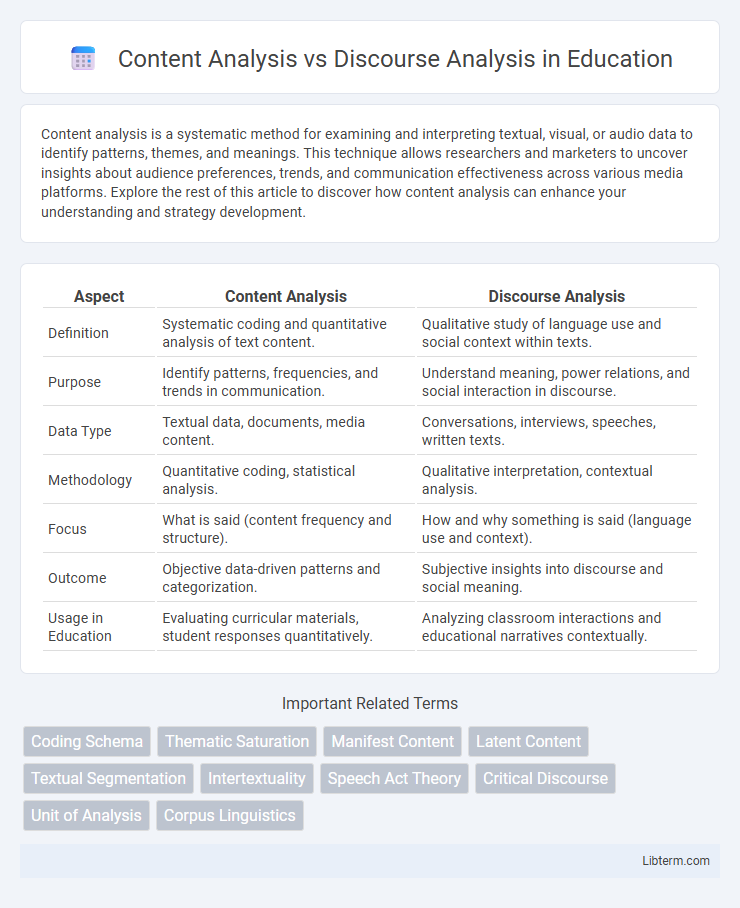Content analysis is a systematic method for examining and interpreting textual, visual, or audio data to identify patterns, themes, and meanings. This technique allows researchers and marketers to uncover insights about audience preferences, trends, and communication effectiveness across various media platforms. Explore the rest of this article to discover how content analysis can enhance your understanding and strategy development.
Table of Comparison
| Aspect | Content Analysis | Discourse Analysis |
|---|---|---|
| Definition | Systematic coding and quantitative analysis of text content. | Qualitative study of language use and social context within texts. |
| Purpose | Identify patterns, frequencies, and trends in communication. | Understand meaning, power relations, and social interaction in discourse. |
| Data Type | Textual data, documents, media content. | Conversations, interviews, speeches, written texts. |
| Methodology | Quantitative coding, statistical analysis. | Qualitative interpretation, contextual analysis. |
| Focus | What is said (content frequency and structure). | How and why something is said (language use and context). |
| Outcome | Objective data-driven patterns and categorization. | Subjective insights into discourse and social meaning. |
| Usage in Education | Evaluating curricular materials, student responses quantitatively. | Analyzing classroom interactions and educational narratives contextually. |
Introduction to Content and Discourse Analysis
Content analysis quantitatively examines textual data by categorizing and coding themes to identify patterns and frequencies within communication. Discourse analysis qualitatively explores language use in social contexts, emphasizing how meaning, power, and identity are constructed through text and conversation. Both methods provide critical insights into media, communication, and social interaction but differ in their analytical focus and interpretative depth.
Defining Content Analysis
Content Analysis is a systematic research technique used to quantify and analyze the presence, meanings, and relationships of words, themes, or concepts within qualitative data. It involves categorizing textual information to identify patterns and trends, often through coding and counting instances of specific content elements. This method emphasizes objectivity and replicability, making it essential for examining communication content in media, social sciences, and marketing research.
Defining Discourse Analysis
Discourse analysis examines how language constructs meaning within social contexts, emphasizing patterns, power relations, and ideologies embedded in communication. Unlike content analysis that quantifies explicit elements in text, discourse analysis explores implicit meanings, narratives, and the societal impact of language use. It involves interpreting spoken or written texts to uncover underlying cultural and social dynamics shaping discourse.
Key Objectives of Content Analysis
Content Analysis aims to systematically quantify and categorize the presence of certain words, themes, or concepts within texts to identify patterns and trends across large datasets. Its key objectives include measuring the frequency of specific terms, coding qualitative data into quantitative formats, and enabling statistical analysis for objective interpretation. This method is primarily used to analyze media content, survey responses, and communication patterns to uncover underlying themes and biases.
Main Goals of Discourse Analysis
Discourse analysis aims to uncover how language shapes social realities, power relations, and ideologies within communication contexts. Unlike content analysis, which quantifies textual elements, discourse analysis interprets meanings, patterns, and social functions embedded in language use. Its main goals include examining language beyond sentence level to reveal cultural norms, identity construction, and interaction dynamics.
Methodological Differences
Content analysis quantifies textual data by systematically coding and categorizing explicit content to identify patterns and frequencies. Discourse analysis interprets language use in context, emphasizing the socio-cultural and power dynamics shaping communication. Methodologically, content analysis relies on structured coding schemes and statistical tools, whereas discourse analysis employs qualitative, interpretive techniques to examine meaning and context.
Data Types and Sources
Content analysis primarily examines quantifiable data from texts, images, or media, focusing on frequency and patterns within large datasets such as newspapers, social media posts, or survey responses. Discourse analysis explores qualitative data by interpreting language use, context, and social interactions found in conversations, interviews, speeches, or online forums to understand underlying meanings and power dynamics. Both methodologies source data differently: content analysis relies on structured, codifiable inputs while discourse analysis engages with unstructured, context-rich communication.
Strengths and Limitations
Content analysis excels in quantifying patterns across large datasets, offering systematic and replicable coding frameworks that yield measurable results, but it may overlook contextual nuances and the deeper meanings behind text. Discourse analysis provides rich insights into language use, power relations, and social contexts by examining how meaning is constructed and communicated, yet its interpretative nature can lead to subjectivity and challenges in standardization. Both methods complement each other by balancing breadth with depth, though their effectiveness depends on research goals and the nature of the data analyzed.
Practical Applications in Research
Content analysis provides researchers with systematic coding and quantification of textual data, enabling objective measurement of themes, frequencies, and patterns in media, surveys, or social media content. Discourse analysis emphasizes the contextual and interpretive examination of language use, revealing underlying power dynamics, social constructs, and ideologies in conversations, interviews, or policy documents. Practical applications of content analysis are prevalent in quantitative studies like media monitoring and sentiment analysis, while discourse analysis is crucial for qualitative research in sociology, linguistics, and communication studies to explore meaning-making processes.
Choosing the Right Approach for Your Study
Content analysis quantifies the presence of certain words, themes, or concepts within qualitative data, making it ideal for studies seeking to measure frequency and patterns. Discourse analysis examines language use, social context, and power dynamics, providing deeper insight into how meaning is constructed and communicated. Selecting the right approach depends on whether the research focuses on statistical trends or interpretive understanding of communication.
Content Analysis Infographic

 libterm.com
libterm.com